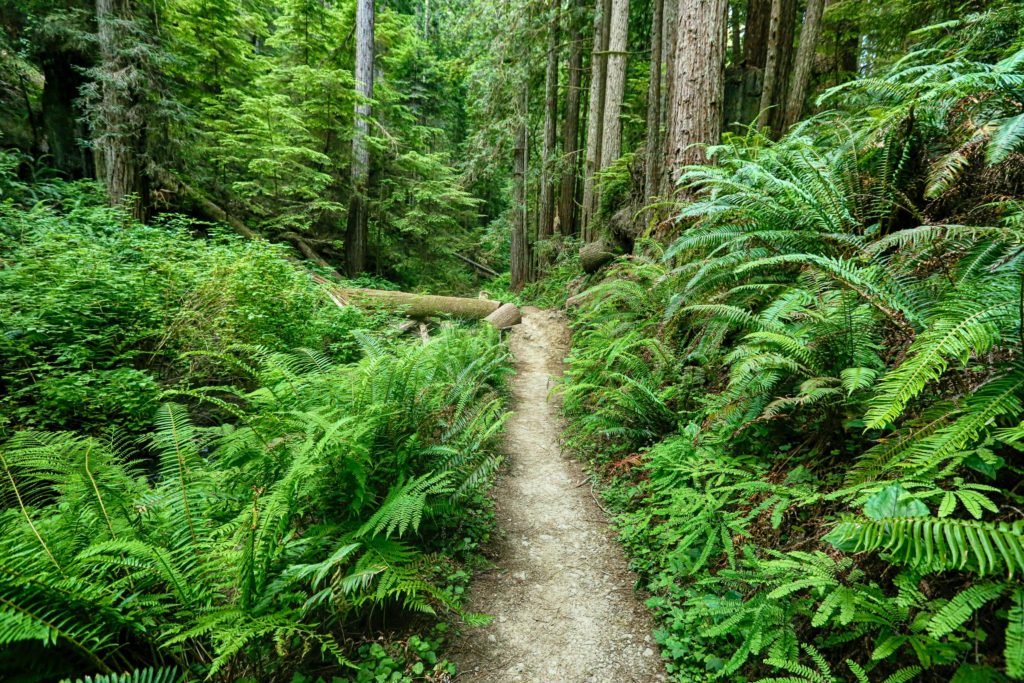Of the many pretty ferns we can grow in our gardens here, one of the nicest ones we can plant is a native one that grows here already. The western sword fern (Polystichum munitum) grows throughout the western states from Alaska down to a little island off Baja California.
If you’ve ever walked through the redwoods by the coast you would have seen the big, bright green, rather prehistoric looking western sword fern growing under the shade of the tall redwoods.
Its fronds grow upright to 2-4 ft. long, resulting in a plant that’s 3 ft. by 3 ft. or larger. It’s a beautiful evergreen fern, easy to grow, and has a high visual impact. A great one for landscape use because it takes full to partial shade which is so common around here in partial forest.
Fairly drought tolerant once it’s established it makes a perfect choice for dry, shady spots under trees or along the north side of the house. You can use it as a ground cover or for erosion control on a shady slope. It tolerates tree root competition.
And, the best yet, it’s deer resistant.
What it likes
Western sword fern likes a humus rich, well-draining soil. But it can tolerate a wide range of soils, as long as drainage is fairly good. And while it prefers shade to part shade, it can handle a little more sun if it’s given extra water.
When planted in the shade, watering once a month, at most, in the summer once it’s established is all it should need. Establishment is after a year or two after planting, when you’ll water more frequently. It will need extra water during heat spells.
Cut out older fronds at the end of winter to keep it attractive. Side-dress the fern with compost to supply nutrients. But it doesn’t need too much.
What the scientific name tells us about it
The genus name Polystichum means many rows, referring to the rows of spore cases on the underside of the leaves. Have you ever noticed the little black or brown dots attractively arranged on the underside of fern leaves? Those are spore cases, which propagate new plants. More on that in a bit. The species name munitum means armed with teeth, referring to its toothed fronds.
Ferns have an interesting life cycle

They propagate themselves in two ways: by spores and by rhizomes. The spores start new plants in quite an indirect way. Each spore sac on fern leaves contains many spores that burst out of the sac when ripe. The spores, which are not seeds, land in moist soil and grow a little heart shaped, flat, green, leaf-like structure called the prothallus. (Don’t worry, there won’t be a quiz.)
Each prothallus has male and female organs. When the sperm is released from the male organ, either from the same prothallus or a neighboring one, one will get to a female organ, if there’s enough water, and fertilize it. That female organ, sitting on the prothallus, develops into a young fern plant, called a sporophyte. It becomes the spore producing fern.
Once big enough the fern starts to send out rhizomes on the soil or just below the surface. That means that your fern plants can spread. Over time you can end up with quite a nice clump of ferns! Eventually you can dig some out and replant in a new spot.
If you’re an adventurous propagator, you can collect the spores and try growing them. There are instructions online.
Native Americans found plenty of uses for this fern
The fronds were spread on drying racks to keep berries from stick or falling through the rack, they lined storage baskets, baking pits, used them as floor coverings and bedding, and for decorations and dancing skirts.
Plant some western sword ferns for your cutting garden
The fronds are commonly used for flower arrangements. It doesn’t hurt them to cut a few to go with your own home grown flowers. They’ll look best if they’re grown in the shade, though. They add a nice structural touch to arrangements and last well in the vase.
Please leave the plants in the wild alone. Wild plant collecting always takes a toll on native populations. The plants are readily available in nurseries. Now that we have had some rain, it’s a great time to plant! Add some compost to the soil and mulch with a little more, and they should be happy.
Remember: deer resistant, low water use, and shady conditions. Perfect for here.

